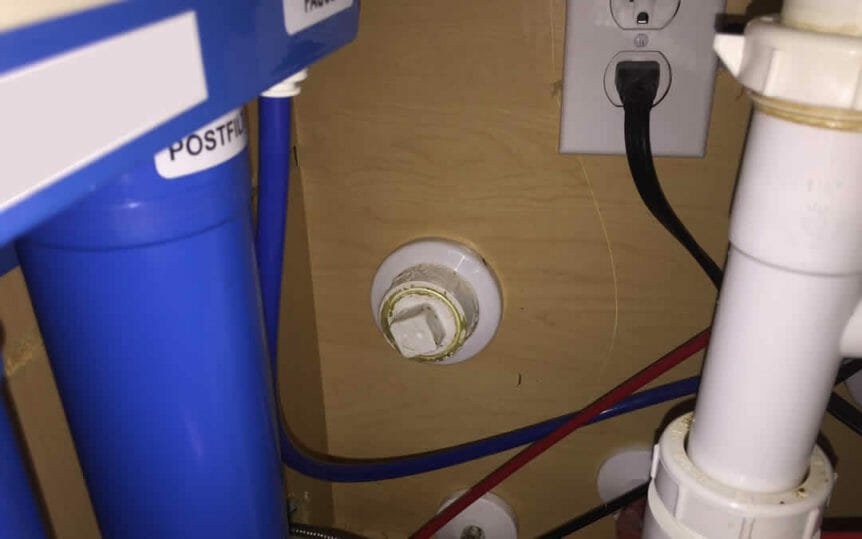
Is Your Drain Line Cleanout Accessible?
Nothing can put a damper on your day like a stopped up drain. Whether the stoppage is in your kitchen causing dirty water to slowly rise up and over your sink or in the bathroom causing your toilet to overflow, it requires immediate attention from you. And you’d rather be doing anything but that, right?
Most people worry about the kitchen or bathroom being torn to pieces by a plumber who is trying to access the line to unclog it. But sometimes the clog is in a cleanout accessible drain. These drains are designed make our lives much easier and chances are your home has at least one. Read on to get the scoop about cleanout accessible drains and to learn how to prevent these drains from getting clogged.
What is an accessible drain?
“What is considered an accessible drain is a drain with a built in cleanout, which is basically a piece of white pipe about four inches across with a screw cap at the end of it,” said John Moore Services Plumbing Trainer and Technician, Joe Bany. “If that line was clogged all the plumber would have to do to fix the problem would be to go over to the white pipe, unscrew the cap, put his machine inside, and clear out the problem.”
All drain lines in a conventional house go to the sewer, but in a septic application, sometimes the kitchen and laundry lines are routed to a different holding tank. An accessible drain cleanout is the part of the drain that can easily be accessed and which plumbers can open up and clear out with different tools. They were designed to create an easy access into your drain line in order to fix stoppages and clogs.
Do I have one and where is it located?
Most homes in the Houston area are equipped with two accessible drain cleanouts. The larger one is connected to your homes’ main line and is located outside, typically about two feet away from your house. It can be in the front or the backyard depending on where your main sewer line runs. The second cleanout is located in the kitchen and is about half the size of the one outside. This drain cleanout is designated for the kitchen sink line only.
“The kitchen sink is the worst, most disgusting line in your home because of the different food, soap, grease and enzymes that get clogged deep down into the line, so that’s why there is a cleanout drain made especially for the kitchen”, said Bany. “The other cleanout line is for the rest of the house, and all houses have them. They are much easier to find on new construction homes, but homes that are 30-40 years old tend to have a harder time accessing them because they can get buried or broken overtime.”
How can I prevent my kitchen line from clogging so much?
Because the kitchen sink has a garbage disposal, you might think that its main purpose is to dispose of all our garbage. We put things like leftover food, lemon wedges, soggy cereal, and grease down the sink and turn on the disposal and the water. When we no longer hear the food rumbling around deep inside the sink we turn off the disposal and think we’re done. Unfortunately, over time that can cause major stoppages.
If the contents you put down your sink are not properly pushed through the drain, they will settle in what are known as “bellies” in the line. Bellies are created overtime by your house shifting and settling and eventually make dips in the line. Imagine your drain as being a pencil that is standing upright with the led pointing upward. All the food that you put down the drain should gradually flow directly down the pencil towards the eraser, or sewer line. But as your house ages and all the food you put down your sink sits in the same spot, bellies, or low spots start to form in your line and stoppages being to develop. Eventually these buildups will become so bad that the line becomes clogged and you will have to call a professional.
“To prevent food from collecting in the bellies of your line its important to push the contents through as best as you can,” said Bany. “When I am doing dishes at my house I run the disposal, turn it off, then put the stopper in the sink. I let the sink fill about half way up with water then pull out the stopper. This forces a lot of water to go through the line at the same time, which pushes all contents that are sitting in the line through to the end. By using your sink a little bit smarter, you can avoid most stoppages.”
What about the bathroom lines?
To avoid clogs in the bathroom, you should flush the lines with water just like you do in the kitchen. In the bathroom sink and shower, hair and soap are the two major causes of clogs. By pouring hot water down your drains once a month, you are flushing all of that gunk down through the drain towards the accessible drain cleanouts.
The stopper in your bathroom sinks and tub can also be extremely beneficial to clear up clogs. Hair and foreign objects collect in the stopper and can cause slow drains. The stopper can easily be removed and cleaned, and is an easy way to clear up a small clog. However, if cleaning these points out does not help your draining issue than snaking your line is the next step, and should probably be done by a professional.
Knowing if you have accessible drains and where they are located is an important part of home maintenance and can end up saving your kitchen and bathroom from being torn apart. But once you find the locations of your accessible drains, you will probably need a professional to come help you clean them out. John Moore Services has trained and certified plumbers ready to help with any of your plumbing problems, so give us a call today!
